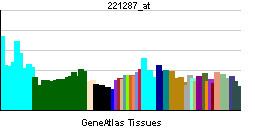Entrez 6041 | Ensembl ENSG00000135828 | |
 | ||
External IDs OMIM: 180435 MGI: 1098272 HomoloGene: 8040 GeneCards: RNASEL | ||
Ribonuclease L or RNase L (for latent), known sometimes as ribonuclease 4 or 2'-5' oligoadenylate synthetase-dependent ribonuclease — is an interferon (IFN)-induced ribonuclease which, upon activation, destroys all RNA within the cell (both cellular and viral). RNase L is an enzyme that in humans is encoded by the RNASEL gene.
Contents
This gene encodes a component of the interferon-regulated 2'-5'oligoadenylate (2'-5'A) system that functions in the antiviral and antiproliferative roles of interferons. RNase L is activated by dimerization, which occurs upon 2'-5'A binding, and results in cleavage of all RNA in the cell. This can lead to activation of MDA5, an RNA helicase involved in the production of interferons.
Synthesis and activation
RNase L is present in very minute quantities during the normal cell cycle. When interferon binds to cell receptors, it activates transcription of around 300 genes to bring about the antiviral state. Among the enzymes produced is RNase L, which is initially in an inactive form. A set of transcribed genes codes for 2’-5’ Oligoadenylate Synthetase (OAS). The transcribed RNA is then spliced and modified in the nucleus before reaching the cytoplasm and being translated into an inactive form of OAS. The location of OAS in the cell and the length of the 2’-5’ oligoadenylate depends on the post-transcriptional and post-translational modifications of OAS.
OAS is only activated under a viral infection, when a tight binding of the inactive form of the protein with a viral dsRNA, consisting of the retrovirus’ ssRNA and its complementary strand, takes place. Once active, OAS converts ATP to pyrophosphate and 2’-5’-linked oligoadenylates (2-5A), which are 5’ end phosphorylated. 2-5 A molecules then bind to RNase L, promoting its activation by dimerization. In its activated form RNase L cleaves all RNA molecules in the cell leading to autophagy and apoptosis. Some of the resulting RNA fragments can also further induce the production of IFN-β as noted in the Significance section.
This dimerization and activation of RNase L can be recognized using Fluorescence Resonance Energy Transfer (FRET), as oligoribonucleotides containing a quencher and a fluorophore on opposite sites are added to a solution with inactive RNase L. The FRET signal is then recorded as the quencher and the fluorophore are very close to each other. Upon the addition of 2-5A molecules, RNase L becomes active, cleaving the oligoribonucleotides and interfering in the FRET signal.
Significance
RNase L is part of the body's innate immune defense, namely the antiviral state of the cell. When a cell is in the antiviral state, it is highly resistant to viral attacks and is also ready to undergo apoptosis upon successful viral infection. Degradation of all RNA within the cell (which usually occurs with cessation of translation activity caused by protein kinase R) is the cell's last stand against a virus before it attempts apoptosis.
Interferon beta (IFN-β), a type I interferon responsible for antiviral activity, is produced by RNAse L and melanoma differentiation-associated protein 5 (MDA5) in the infected cell. The relationship between RNAse L and MDA5 in the production of IFNs has been confirmed with siRNA tests silencing the expression of either molecule and noting a marked decline in IFN production. MDA5, an RNA helicase, is known to be activated by long dsRNA transcribed from the viral genome. In a cell with RNAse L, MDA5 activity may be further enhanced. When active, RNAse L cleaves and identifies viral RNA and feeds it into MDA5 activation sites, enhancing the production of IFN-β. The RNA fragments produced by RNAse L have double stranded regions, as well as specific markers, that allow them to be identified by the RNAse L and MDA5. Some studies have suggested that high levels of RNAse L may actually inhibit IFN-β production, but a clear linkage still exists between RNAse L activity and IFN-β production.
Furthermore, it has been shown that RNase L is involved in many diseases. In 2002, the “hereditary prostate cancer 1” locus (HPC1) was mapped to the RNASEL gene, indicating that mutations in this gene cause a predisposition to prostate cancer. Impairments of the OAS/RNase L pathway in chronic fatigue syndrome (CFS) have been investigated.
